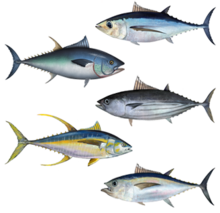| Tuna | |
|---|---|

| |
| Tunas (from top): albacore, Atlantic bluefin, skipjack, yellowfin, bigeye | |
| Scientific classification | |
| Domain: | Eukaryota |
| Kingdom: | Animalia |
| Phylum: | Chordata |
| Class: | Actinopterygii |
| Order: | Scombriformes |
| Family: | Scombridae |
| Subfamily: | Scombrinae |
| Tribe: | Thunnini Starks, 1910 |
| Genera | |
| |
A tuna (pl.: tunas or tuna) is a saltwater fish that belongs to the tribe Thunnini, a subgrouping of the Scombridae (mackerel) family. The Thunnini comprise 17 species across five genera,[2] the sizes of which vary greatly, ranging from the bullet tuna (max length: 50 cm or 1.6 ft, weight: 1.8 kg or 4 lb) up to the Atlantic bluefin tuna (max length: 4.6 m or 15 ft, weight: 684 kg or 1,508 lb), which averages 2 m (6.6 ft) and is believed to live up to 50 years.
Tuna, opah, and mackerel sharks are the only species of fish that can maintain a body temperature higher than that of the surrounding water. An active and agile predator, the tuna has a sleek, streamlined body, and is among the fastest-swimming pelagic fish – the yellowfin tuna, for example, is capable of speeds of up to 75 km/h (47 mph).[3][4] Greatly inflated speeds can be found in early scientific reports and are still widely reported in the popular literature.[4]
Found in warm seas, the tuna is commercially fished extensively as a food fish, and is popular as a bluewater game fish. As a result of overfishing, some tuna species, such as the southern bluefin tuna, are threatened with extinction.[5]
| This article is part of a series on |
| Commercial fish |
|---|
| Large predatory |
| Forage |
| Demersal |
| Mixed |
- ^ "Tribe Thunnini Starks 1910". The Paleobiology Database. Archived from the original on 21 January 2019. Retrieved 20 January 2019.
- ^ Cite error: The named reference
Graham2004was invoked but never defined (see the help page). - ^ Block, Barbara A.; Booth, David; Carey, Francis G. (1992). "Direct measurement of swimming speeds and depth of blue marlin". Journal of Experimental Biology. 166: 278. doi:10.1242/jeb.166.1.267.
- ^ a b Svendsen, Morten B. S.; Domenici, Paolo; Marras, Stefano; Krause, Jens; Boswell, Kevin M.; Rodriguez-Pinto, Ivan; Wilson, Alexander D. M.; Kurvers, Ralf H. J. M.; Viblanc, Paul E.; Finger, Jean S.; Steffensen, John F. (October 2016). "Maximum swimming speeds of sailfish and three other large marine predatory fish species based on muscle contraction time and stride length: a myth revisited". Biology Open. 5 (10): 1415–1419. doi:10.1242/bio.019919. PMC 5087677. PMID 27543056.
- ^ Cite error: The named reference
IUCNmaccoyiiwas invoked but never defined (see the help page).
